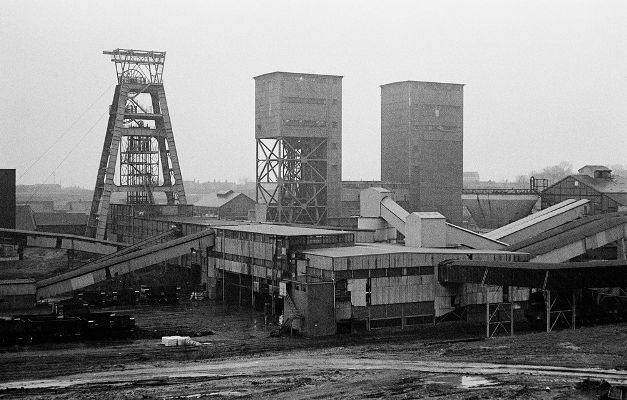
Brodsworth Main Colliery 1985
Copyright © Bjorn Rantil and used with his kind permission
This colliery was a joint venture between the Hickleton Main Colliery Co. and Staveley Coal & Iron Co., which each had a half share in the Brodsworth Main Colliery Co. Ltd. Like all surrounding pits it was a green field development neighbouring small, agricultural villages. The chosen site was, however, between the South Yorkshire Junction Railway and the LNER line from Wakefield to Doncaster.
The first sod of the two 6.25 metre diameter shafts was cut on October 23rd 1905. The first 58.5 metres were through Permian age strata, then the Coal Measures were entered. The Barnsley seam was reached at a depth of 541 metres in 1907, but sinking continued, through the Dunsil at 556 metres, the Pargate at 742 metres and the Thorncliffe at 767 metres. All of which were eventually worked. Ignoring coal got during development, coal getting from the Barnsley seam began in 1908 and the workforce grew rapidly in subsequent years. It was worked without break until 1984.
The Dunsil (Barnsley Deep) seam was worked between 1920 and 1922, but then left until 1941 when it was worked continuously until 1984.
The Parkgate seam also worked between 1920 and 1922, but was reopened in 1925 to be discontinued in October 1927. The seam was also worked from 1934 to 1950 and from 1955 to 1986. A third shaft, sunk between 1922 and 1923, greatly increased Brodsworth’s coal raising capacity. This increased the numbers employed underground from around 2500 to 3500 by 1925.
The Coal Mines Act (1930) sought to rationalise the industry through mergers, price and output controls. From 1937, therefore, Brodsworth Main Colliery Co. Ltd became part of the Doncaster Amalgamated Collieries Ltd, which worked until it was nationalised. Other pits in that scheme were: Hickleton Main, Markham Main, Yorkshire Main, Bullcroft and Thurcroft.
The Thorncliffe seam was worked from 1951 to 1989.
In 1960 the headgears on Nos 1 and 2 pits were replaced with winding towers, with coal winding done in 22 ton capacity skips.
An underground link with Bullcroft colliery was completed in June 1970 and the latter’s coal was thereafter raised at Brodsworth. The two mines were merged in October and Bullcroft’s workforce was transferred to Brodsworth.
In 1971 a rapid loading bunker was added in order to accommodate Merry Go Round trains from local power stations.
Brodsworth began making losses in the late 1980s and was closed by British Coal on September 7th 1990. The surface plant was demolished in 1991.
Further reading:
- NMRS Records, Gazetteer of British Collieries
- Sections of Strata of the Yorkshire Coalfield, Midland Institute of Mining Engineers, 1927
- Hill, A. The South Yorkshire Coalfield: A History and Development (Stroud: Tempus, 2002)
- Hill, A. Colliery Ventilation (Matlock: Peak District Mines Historical Society Ltd, 2000)
- Hill, A. Coal: A Chronology for Britain (NMRS, British Mining No.94, 2012).

